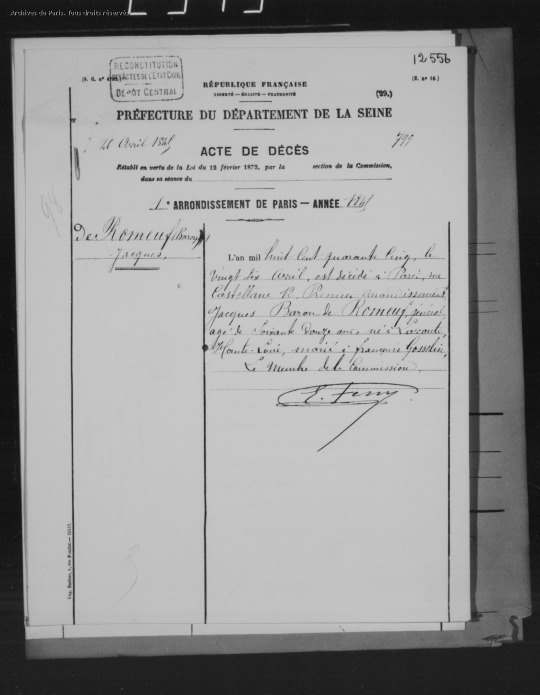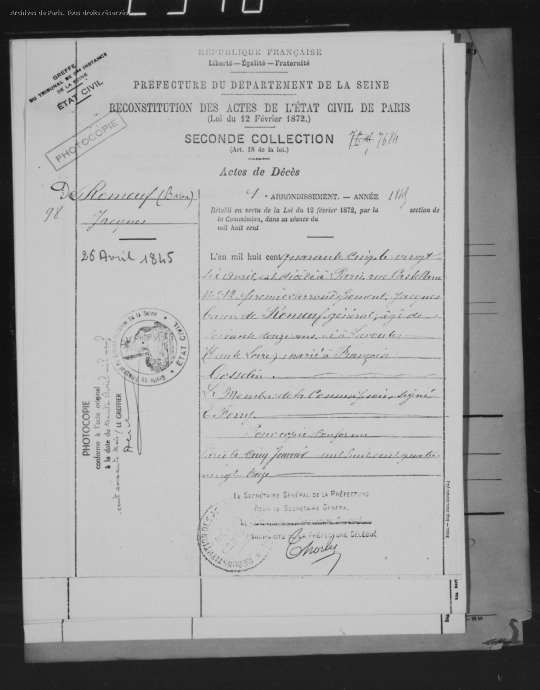#germain primes
Explore tagged Tumblr posts
Note
NOT THIS??? https://twitter.com/Teta_2023/status/1644126646415560706
They act like the terms of his contract aren't publicly available and we didn't see it all play out since last season omg they really believe this innocent little blorbo image they've made up for this grown ass man and his European superiority complex so tired of them


#oh brother.......................#listen they can bring up the image rights thing all they want but the not wanting to exclude others excuse is bs lmfao#like i said it's astounding to me that he has sm influence over the ultras but he's never thought for a minute#to tell them to maybe stop booing and whistling his teammate when he's actually been the best player this season?#'it's not kylian saint germain' bruv who are you trying to fool it very much is and some of your fans even enjoy the fact that it is 😭#speaking of the european superiority thing#while it's true there's nuance to this since he's black but he's definitely spoiled. and the comment abt south american football.. yeah ://#i have never seen a player this protected in my life. and don't even get me started on his salary when you consider how he hasn't won#psg anything of note. i mean who am i in my going-broke-trying-to-pay-for-my-law-degree ass glory to judge how much he earns#but the fact that he earns more than prime messi and cr7 did in their time and gets a loyalty bonus that goes up each YEAR#and still throws tantrums on ig and throws his club under the bus instead of settling issues privately is. well. lmfao#idk where im going with this anymore but i think it's clear by now that im not too fond of him and i really need messi out of here FAST#asks#unrelated but the fact that there are kykymi girlies who still exist despite the rape allegations is 🤢
7 notes
·
View notes
Photo

Treaty of Paris of 1783
The Treaty of Paris, signed on 3 September 1783 by representatives from Great Britain and the United States, was the peace agreement that formally ended the American Revolutionary War (1775-1783) and recognized the United States as an independent nation. The treaty was considered generous to the United States, fixing its border at the Mississippi River and thereby doubling its territory.
Background: The World Turned Upside Down
On 19 October 1781, the battered British army marched out of Yorktown, Virginia. Dressed in resplendent new uniforms freshly issued for the occasion, the British soldiers passed between the French and American armies to throw their muskets onto a steadily growing pile of surrendered arms. Emotions were running high; some British soldiers wept as they laid down their weapons, while others haphazardly threw their muskets onto the pile in the hopes that they would smash. Lord Charles Cornwallis, commander of the surrendering British army, was not present at the ceremony, having pled illness. It was left to his second-in-command, General Charles O'Hara, to offer his sword to American General George Washington, who refused, instead motioning for O'Hara to give the sword to his own second-in-command, General Benjamin Lincoln. According to legend, as the ceremony took place, the military bands played a tune aptly titled "The World Turned Upside Down".
As this dramatic scene suggests, it was immediately apparent that the Siege of Yorktown marked an important turning point in the war. But in the direct aftermath of the siege, few could have anticipated just how significant it had been. Despite Cornwallis' surrender, the British army certainly had the military capacity to continue fighting, as they still possessed sizable military presences in New York City, Charleston, Canada, and the West Indies. Indeed, King George III of Great Britain (r. 1760-1820) and Prime Minister Lord Frederick North, had every intention of planning a campaign for the upcoming 1782 season. The king and his ministers knew that the fledgling United States was on the verge of failing. The Continental currency issued by Congress was worthless, and many of the underpaid soldiers of the Continental Army were close to mutiny. To top it all off, the treasury of the Kingdom of France was running dangerously low, leading the French to hint that they would have to exit the war if peace was not soon concluded. All King George III and Lord North had to do was prolong the war for a year or two more, and the American rebellion would collapse in on itself.
But unfortunately for the king and his ministers, the British people had long been experiencing war fatigue, and the defeat at Yorktown was the final straw. This attitude was reflected in Parliament when it reconvened after its Christmas recess in January 1782. While many in Parliament did not necessarily approve of an independent United States, they were more concerned about the negative impact that the war was having on British resources and international prestige, particularly after the conflict had taken on a global scale with the entry of France and Spain in 1778-79. Year after year, members of Parliament had listened to Lord North give excuses as to why British arms had failed in North America during the previous campaign season, before promising that a British victory loomed just over the horizon. Now, when news of Cornwallis' surrender reached London, they had finally had enough. In February 1782, colonial secretary Lord George Germain was forced out of the cabinet, with Lord Sandwich, First Lord of the Admiralty, losing his position soon after. The house of cards finally collapsed on 20 March, when Lord North resigned rather than face the indignity of being removed from office by a vote of no confidence. George III himself even considered abdicating the throne but was persuaded against it.
Lord North
National Portrait Gallery, London (CC BY-NC-ND)
North was replaced as prime minister by Charles Watson-Wentworth, 2nd Marquess of Rockingham, whose political faction, known as the 'Rockingham Whigs', had opposed many of the policies of the North ministry including the war in North America. Supported by influential British politicians like Charles James Fox and Edmund Burke, Lord Rockingham immediately took steps to end the war upon coming to power; the king, who despised Rockingham – indeed, the two could not even be in the same room – could do nothing as the new ministry set about bringing seven years of war to an end. In April 1782, Rockingham sent a representative to Paris to begin informal peace talks. When Rockingham unexpectedly died the following July, the Earl of Shelburne became prime minister and took up the supervision of the negotiations.
Continue reading...
30 notes
·
View notes
Text
My mental images of the character in SINF
Nicholas Flamel- The Needle (Earth-Prime: Stargirl)

Jonh Dee- Vlad (Danny Phantom)

Palamedes- Varatos Vex (3Below) It's just the vibe you know

Odin- Odin (Marvel) The first Odin I've ever know

Hel- Blank-Eyed Girl (Adventure Time) and maybe imagine her hair and dress as cape or something

Virginia Dare- Huntress Wizard (Adventure Time)

Comte de Saint-Germain- yes, he's a colourbent Vee (The Owl House)

Niten- that one Kraangdroid with sunglasses (TMNT 2012)

Prometheus- Alder (Pokemon Black amd White) mix with Helios (Punderworld), with Dan Mora artstyle and shirtless. Yes, very specific

Tsagaglalal- Vera Tennyson (Ben 10) but with blue dress)

Hecate- this is an illustration of Hestia I found on the internet, not mine. The closest picture I could find

Scathach- this random picture I found on Pinterest, also wear an orange sleeveless turtle neck, black sweatpants (I think?) and black boots

Abraham the Mage- the first Abraham I've ever know and he won't get out of my head

P/s: Marethyu- Aquaman (Justice League Unlimited) this took me a while to find, maybe cause I always imagine him with a dark green cloak with the hood cast a shadow on his right eye

#This happened because I never read the character description properly#Just depending on different stuffs throughout the books#Secrets of the Immortal Nicholas Flamel#SINF#Stargirl#Danny Phantom#3Below#Marvel#The Owl House#Pokemon#Punderworld#Ben 10#Justice League Unlimited#Adventure Time#Teenage Mutant Ninja Turtles#Teen Titans Go
15 notes
·
View notes
Text
I find radical feminism interesting and enlightening as a philosophy, like of all the branches of feminism I've read, it's the only that touches on topics that have bothered me for a very long time:
Why are women in the west expected to wear clothes that are more form fitting and show more skin than their male counterparts? Noticeable at almost every level of professionalism - even women who wear suits tend to wear scoop neck blouses to show collarbone and upper chest. Or they wear a skirt suit, which shows the legs.
Why is asking this question contentious? I get serious pushback from other women when I wonder about this, as if I were judging them. (I'm not - I'm curious about this gendered clothing system we live in.)
Why is the subjugation of women so common across the world? Why is it so similar across cultures and epochs?
How did the subjugation of women happen? What are the situations that lead to female subjugation?
How have women won back territory? What are the situations that lead to female liberation? How can we organize to take advantage of these opportunities?
To what extent is the female body the source of female oppression? Are we actually doomed by sexual dimorphism, or is this just pessimism? What is and is not true of the female body?
Are there genuine differences between females and males when it comes to psychology? If so, to what extent are these differences useful, or to be encouraged in women?
Radical feminism, of all the branches of feminism I've read about, is the one that comes closest to answering these questions. Liberal feminism is quite incurious about the origin of female oppression, and lacks a global thrust. Cultural feminism takes too much for granted that what we've been told is "feminine" is real and valuable. Ecofeminism often seems to delve straight into woo. Radical and Marxist feminists are the ones who seem to get the most that feminism is, at its core, a movement about female power and male power.
My problem with radical feminism is that while there's a tremendous amount of reading about feminist theory, there's spotty coverage of other issues. Radical feminism has a cautious relationship with science - understandable, since science has a dirty history of being used to justify the superiority of {$insert group using it here}, but sometimes veering into denialism. Like in Germaine Greer's Female Eunuch, she disputes the now accepted claim that women tend to have more fat than men, and says this was made up by sexist scientists. I've seen radical feminists unsceptically quote that Cordelia Fine book where she talks about 'priming' without even mentioning the replication crisis related to priming or trying to tease apart which studies still hold and which ones don't. This may seem like nitpicking, but living in reality matters. If we base our activism on the basis of a false claim ("there is no sexual dimorphism in fat distribution!") or a weak/contentious claim ("priming is a real thing that explains poorer female performance in certain areas"), then we end up following the wrong path and chasing leads that don't matter.
That being said, nobody else has done a better job, in my opinion, of dealing with the issues that go to the core of female subjugation, and the weak points can still be improved. Moreover, nobody else argues the urgency of female liberation with as much breadth as radical feminists have. Reading Dworkin and Firestone felt like someone had ripped open my diary, found the questions I had, and answered them with electrifying clarity.
105 notes
·
View notes
Note
26 for the ask game (╹◡╹)
26. Forgotten hero everyone should know about
This could have been a perfect occasion to talk about Claude-Antoine Prieur again, but given that I plan to devote him many future posts on my blog, I thought it would have been more appropriate to use this ask to share my knowledge about an important and unfortunately still rather unknown STEM personality, who truly inspired me when I was a young student. I'm referring to Sophie Germain.

Born in Paris in 1776, Sophie was one of the rare mathematiciennes of the 18th-19th century. She had her first approach with mathematics during the days of the storming of the Bastille, when it was too dangerous for a young 13 years old girl to go outside. To pass the time, she turned to her father's library and a book named "Histoire des mathématiques" by Jean-Étienne Montucla captured her interest. The story of Archimedes narrated in the book fascinated her deeply, eventually leading her to start studying mathematics on her own through the works by famous mathematicians like Euler, Newton, Cousin. Her interest and dedication to the discipline was so strong, that during winter, when her parents denied her warm clothes and a fire in her bedroom to prevent her from studying she kept doing it anyway despite the cold; at the time maths wasn't considered appropriate as a studying discipline for a woman.
When the Polytechnic school opened in 1794, women couldn't attend, but the policy of the school allowed to everyone, who asked for them, notes of the lectures. She requested them under the pseudonym of Antoine-Auguste Le Blanc, a former student who had dropped out. Given that, as a student of the Polytechnic school, one was expected to send written observations about the lectures - a sort of homework - Germain wrote and sent hers to Joseph-Louis Lagrange, one of the teachers and renowned mathematician. The latter was so positively impressed by her essays that requested a meeting with the brilliant student LeBlanc, who unexpectedly had improved so much. She was then forced to reveal her identity. Lagrange was pleasantly surprised to realize Monsieur Le Blanc was in reality a young and talented woman and decided to support her, becoming her mentor.
One of her most noteworthy contribution to mathematics was in number theory, where she proved a special case of the so-called Last Fermat's Theorem (1), which has remained one of the hardest mathematical theorems to prove for more than three centuries and whose final proof was actually found only in 1994 by Andrew Wiles. Other important works of hers include treatises on elastic surfaces, one of which, Recherches sur la théorie des surfaces élastiques, awarded her a prize from the Paris Academy of Science in 1816.
Although she often faced prejudice for being a woman, Germain was praised and also supported by various well-known mathematicians of the time. Some of them include the aforementioned Lagrange, Legendre, who thanks to her work on the Fermat's theorem, was able to prove it for another special case; Cousin himself, Fourier, who managed to grant her the permission to follow the sittings held at the Paris Academy of science and last, but obviously not least, the great Gauss, who after Germain's death advocated for giving her an honorary degree in mathematics.
Notes
(1) In short, the Last Fermat's Theorem asserts that for n > 2 there are no integer solutions to the following equation:

with a, b, c being positive integers. Sophie Germain proved the theorem for all numbers n equal to a prime p, so that 2p + 1 is also prime. The whole thing is much more complex that how I explained it, my aim was to write down a simple intoduction. If you want to read more about that I recommend you this link.
21 notes
·
View notes
Text
Alto Bordo
Come mi ero promesso, ogni trimestre sto recuperando un classico in lettura. Martedi ho finito di leggere La Signora Delle Camelie di Alexandre Dumas Figlio. Pubblicato nel 1848, capolavoro della letteratura dell'Ottocento, Dumas racconta la storia d'amore tra Marguerite Gautier e Armand Duval, un affresco incredibile, e dai tratti molto moderni (soprattutto per quanto riguarda il carattere e le idee di Gautier, tanto che all'epoca fece scandalo e trascinò il romanzo ad un tumultuoso successo) di quel demi monde del tempo, cioè un ambiente sociale corrotto e che ostenta gli atteggiamenti propri di un ceto elevato (lo stesso Dumas scrisse una commedia nel 1855 dallo stesso titolo, e fu lui l'inventore di questo termine).
Più che la storia, celeberrima anche perchè Dumas ne ricavò un'opera teatrale in 5 atti e Giuseppe Verdi ne musicò una versione su libretto di Francesco Maria Piave, La Traviata (1853 la prima rappresentazione) considerata il suo capolavoro e che fu tratta direttamente dalla trasposizione teatrale di Dumas e da allora una delle opere liriche più famose e rappresentate del mondo, c'è un particolare meno noto.
A fine libro Dumas scrive: "...scrissi questa storia esattamente come mi era stata raccontata. Essa ha un solo merito che le sarà contestato, quello di essere vera". Non è solo un espediente narrativo, ma è davvero la realtà: Dumas infatti si ispirò alla sua relazione con Marie Duplessin per il personaggio di Marguerite. Eccola in un bellissimo quadro dell'artista Édouard Vienot

Nata poverissima in Normandia, fu presto abbandonata dalla madre. Il suo vero nome era Alphonsine Rose Plessis, e quando arrivò giovanissima a Parigi, lavorando come sarta, un negoziante, per cui lei lavorava, nel 1839, quando ha solo 15 anni, diviene il suo primo amante. Inizia così una scalata sociale incredibile, in pochi mesi diviene l'amante di personaggi sempre più illustri e la protagonista delle serate mondane parigine. Cambia nome in Marie Duplessis, in cui l'aggiunta del du al cognome d'origine, conferisce un tocco aristocratico, impara non solo a leggere e scrivere (arriverà ad avere una biblioteca enorme) ma anche a suonare il pianoforte, diviene l'amante di uno dei più potenti aristocratici parigini, e fece scandalo incredibile la sua relazione con Agénor de Gramont duca di Guichem, che innamorato pazzo di lei si fa vedere ovunque con Marie, tanto che la famiglia, scandalizzata dalla frequentazione di tale personaggio, gli impone di lasciare Parigi. Con Dumas, ebbe una relazione di circa un anno, dal settembre 1844 all'agosto 1845. Alexandre e Marie trascorrono un periodo insieme in campagna a Saint-Germain-en-Laye, un piccolo comune dell'Ile de France a poca distanza da Parigi (episodio che verrà replicato identico nel libro, quando Armand e Marguerite vanno a Bougival, paesino che diventerà una sorta di mito dei dintorni di Parigi per il romanzo e perché buen ritiro dei maggiori pittori impressionisti). Dumas la lascia con una famosa lettera, che esiste ancora, dopo l'ennesimo tradimento. Tra gli amanti famosi, anche il compositore Franz Listz, il conte svedese von Stakelberg, ambasciatore a San Pietroburgo e il conte Édouard de Perrégaux col quale convola a nozze a Londra nel 1846. Travolta dai debiti e soprattutto debilitata dalla tisi, muore il 3 febbraio 1847. Ai suoi funerali partecipa una folla enorme e la vendita all'incanto dei suoi beni, disposta per risarcire i numerosi creditori, vedrà i partecipanti strapparsi di mano, con morbosa attrazione, gli oggetti andati all'asta, e tra i pezzi forti le opere prime di famosi romanzi dell'epoca firmati per lei dai più grandi autori (anche questo fatto ripreso pari pari nel romanzo). Aveva passione per i gioielli, per le stole di pellicce, per i cavalli e soprattutto per le camelie, sempre presenti nel suo appartamento: spesso rosa e bianche, rosse quando non poteva ricevere i suoi amanti.
Marie Duplessis è la più famosa delle lorette: il termine fu coniato dal giornalista Nestor Roqueplan in un articolo del 20 Gennaio del 1841 su uno dei primi giornali autoprodotti, una cosiddetta Nouvelles à la main, che aveva indicato le cortigiane con un certo gusto e stile con questo termine, preso in prestito dalla Chiesa della Madonna di Loreto (Notre Dame De Lorette, nel IX arrondissement.

Lì si radunavano le giovani donne con stile, che si contrapponevano alle grisette (le sartine), che popolavano il quartiere latino, che erano ragazze che vivevano fuori dalla famiglia che accettavano regali dagli uomini di ceto sociale più elevato, senza necessariamente prostituirsi: grisette deriva da quello di una stoffa adatta da lavoro, con la quale si confezionavano vestiti di basso valore, spesso di colore grigio. È interessante come dei toponimi indicassero in maniera elegante un mestiere che sebbene all'epoca niente affatto scandaloso, veniva "nascosto" perchè in società non si poteva dire.
15 notes
·
View notes
Text

Didn't think this mattered when I reviewed the concept art a while back, but I talked to multiple people who mentioned that someone out there seemed to have theorised that rough draft Judge was going to be a Tenryuubito/Celestial Dragon, so I'm reviewing this again.
The handwritten note says: "The Count of Mechanics (Karakuri Danshaku からくり男爵), Saint Germain サンジェルマン. Sanji's dad, 56 years old". The printed note talks about how there's no raid suit and spear yet, and this is a rough draft of him "back when he was a [great man]". I presume this means "in his prime".
I'm assuming the Tenryuubito claim comes from the "Saint" of Saint Germain. It's actually completely different, though, so I think whoever made that claim either had a misunderstanding or was just extrapolating data to make theories. I'm open to that having been the case, but the straightforward reading of this says that's not the case.
The "Saint" used for the Tenryuubito is written in kanji: 聖 (sei), and used as a suffix. For example, what is translated as "Saint Mjosgard" would be written "Mjosgard-聖" in the raw.
Saint Germain is just a single name, based on Comte de Saint Germain of history and legends, and written as "San Jeruman" in katakana. That's why he's titled a "Count" (or Earl) after the real Saint Germain, and it's completely different from the Tenryuubito's "saint".
We know that sensei likes puns, so maybe it was meant to be an allusion. Comte de Saint Germain in real life is someone associated with legends involving immortality (or at least living for hundreds of years), and a hell lot of mysticism, so it's not impossible that this name was meant to allude to something really suspect. It's just that unless sensei says anything else, nothing about this name as it is says "he was originally meant to be a Tenryuubito".
All this note tells us (for now) is that while the Vinsmokes were always meant to be of noble lineage, they seem to be originally not royal before (just a count/earl). However, they were always meant to be related to technology (からくり karakuri is originally mechanics along the lines of clockwork, but can be applied to other types of machinery too).
Besides, "San Jeruman" seems more like a Sanji pun. In Japanese "je" is formed by combining a "ji" ジ and a "small e" ェ. So the name "Saint Germain" contains "Sanji" as part of the spelling.

I mean, I sometimes write my theories in a word vomit post and forget some facts while I was writing, so I might say something that's wrong. It happens. But, you know, this is just not true.
22 notes
·
View notes
Text
A Quebec man who pleaded guilty to threatening Prime Minister Justin Trudeau and Premier François Legault has been sentenced to 20 months in jail.
Crown prosecutor Geneviève Crépeau confirmed to Noovo Info that a judge delivered the sentence Friday at the Sherbrooke courthouse.
Germain Lemay, a resident of Hampden in the Eastern Townships, admitted in January to uttering threats toward the two politicians in videos posted between July and September 2023, as well as making similar threats toward any police officer who came on his land and toward an employee of Quebec's workplace health and safety board.
The Crown had sought a 20-month imprisonment sentence, while the defence was seeking a sentence of two years less a day to be served in the community. [...]
Continue Reading.
Tagging: @newsfromstolenland
11 notes
·
View notes
Text

Ph.Vivian Maier
"Tout ce qui excède en intensité, en présence, en saveur, laisse un reste."
Sylvie Germain "Petites scènes capitales"
Cliché stupéfiant qui me retourne au temps de C. et moi et notre amitié ou plutôt notre amour extraordinaire de gamines. C. était (est toujours puisqu'elle est devenue professeur de musique) une mélomane clarinettiste passionnée, petite mirguette gentille et malicieuse, toujours gaie, malgré un bec de lièvre dont elle ne se plaignait jamais. Au primaire, en CM2, dans notre minuscule village de campagne, les onze filles et le seul garçon de la classe, jouions toutes ensemble (excuse-moi Charles mais là le féminin l'emportais clairement sur le masculin) avec une grande complicité et tellement d'entrain.
Arrivées au collège et à cause de l'éclatement de notre groupe, tout à changé... Les quatre années terribles nous sont tombées sur le coin du museau à C et moi. Surtout à C d'ailleurs, c'est le cas de le dire.
Les réseaux sociaux n'ont pas inventé le harcèlement; ils n'ont rien inventé d'ailleurs, juste amplifié la chose.
C. a subi tous les outrages de la part des élèves du collège Louise Michel (Filles comme garçons mais surtout filles dont deux très acharnées, en l’occurrence S. une de ses anciennes "amies" de l'école) parce qu'un ange avait posé un doigt en travers de sa bouche juste avant sa naissance.
Elles et ils la traitaient de tous les noms d'oiseaux (j'ai lu ici un jour, un thérapeute reprendre les mots de Freud : « Le premier homme à jeter une insulte plutôt qu'une pierre est le fondateur de la civilisation. ») Mais oui bien sûr !! ça m'a fait bondir d'indignation. Tu ne jetteras ni l'une ni l'autre ni avant ni après ni pendant, ni jamais. Elle, C. elle avait les deux en prime. Bousculades, on venait nous marcher sur les jambes quand nous prenions le soleil, assise contre le mur. J'ai giflé violemment un jour une grandasse de 3ème parce qu'elle avait fait tomber C. du banc pour lui prendre sa place. C. ne se défendait pas, elle était incroyablement timide, apeurée. Et moi, j'étais ivre, secouée tremblante de colère, de fureur, car les adultes, professeurs comme parents VOYAIENT cela, ce qui se passait et aucuns ne levaient le petit doigt.
Sauf, Mr B. notre professeur de français... Il nous a demandé un jour de faire une rédaction sur le thème de l'amitié... J'ai écrit sur la nôtre à C. et moi et puis il m'a mis la meilleure note et l'a lue à toute la classe de 3ème. Je me souviens du silence ensuite. Seulement de cette suspension claire de sons, baignée de soleil qui rentrait à flots par les baies vitrées du préfabriqué. Un grand et beau mutisme, bien épais comme après un K.O sur un ring de boxe. Au ralenti. C. et moi assises côte à côte, on se regardait en douce, en souriant, se touchant la main...
Plus rien n'a été comme auparavant depuis ce jour de juin. La tempête a enfin quitté la mer. Grâce à l'intervention subtile, fine, intelligente, de notre professeur de français. Merci Monsieur B.
Beaucoup. Énorme aimant. A jamais.
9 notes
·
View notes
Text
by Benjamin Weinthal,
Qatar's support for Hamas likely played a role in the collapse of the $6.31 billion deal which would have transferred ownership of English Premier League powerhouse Manchester United Football Club from the American Glazer family to Qatar's Sheikh Jassim Bin Hamad al Thani, the son of Hamad bin Jassim (HBJ) the former prime minister of Qatar. Sheikh Jassim withdrew his bid just days after the massacre, which resulted in the deaths of 14 British nationals.
The Manchester Evening News reported October 16 on this author's article on about the role of HBJ in stoking antisemitism. FWI highlighted Jassim's antisemitism in a September 29 article that cited a translation by the Washington-based Middle East Media Research Institute (MEMRI). HBJ told Kuwaiti media outlet Al Qabas that if oil was sold by Jews, "It would be the most expensive thing in the world." HBJ worked with his son to raise funds for their now-defunct bid to buy Manchester United.
In its coverage, the Manchester Evening News noted "It would be remiss to overlook the fact the Glazers are Jewish" in light of HBJ's antisemitic statements and the implosion of the deal.
Marc Eichinger, a former French intelligence agent, told FWI that "It was important that they did not buy Manchester United because it is a tool of influence" for Doha. He said Qatar has no genuine interest in football as a sport and that the country's ownership of the Paris Saint-Germain Football Club "is used to corrupt and attract people" that can prove useful to the regime.
"An example is journalists who are invited to the VIP room at Paris Saint-Germain Football Club and have contact with people of notoriety—politicians. This has value and they reward Qatar with positive exposure," Eichinger told FWI.
8 notes
·
View notes
Text
History of 悪ノ娘 -Album-
The History of Daughter of Evil album booklet content
There are many mysteries left in the history of "Daughter of Evil".
.
Lucifenia's glorious and bloody history.
The aggressive war led by King Arth with the goal of uniting all of the Evillious region under one banner,
Can be said to be its beginning.
.
The armies led by the king's loyal subordinates, the Three Heroes,
Greatly expanded his small country's territory in a short period of time.
The war was brought to an end by King Arth falling ill,
But by that point, Lucifenia had already become the most powerful country in the region.
.
After the king's death, Lucifenia experienced a brief revolt caused by the machinations of its prime minister.
One of his candidates for heir, Prince Alexiel, went missing from the public eye.
.
Lucifenia's governance was transferred to Arth's queen, Anne,
But she too wound up dying young from illness just like her husband.
.
The only one left was the fourteen-year-old Princess Riliane.
She was inexperienced, lacking the charisma of her father and the intelligence of her mother.
.
The country smoldered in discontent.
The political purges she enacted to bring it under control served only to spark the flames of destruction.
.
The assassination of Leonhart, one of the Three Heroes.
An invasion against a neighboring country over the princess' personal grudges.
These wound up becoming motivations for the eventual revolution.
.
The revolutionary army led by Germaine, Leonhart's daughter, surged into the palace and captured the princess.
The revolutinary army's fighting strength was poor, being comprised primarily of regular townsfolk, but their attempt was successful.
We can posit several key reasons for this.
The low morale of the kingdom's army due to their unnecessary invasion.
The loss of the authority of the Three Heroes.
And aid given to the revolutionary army from the nearby country of Marlon.
.
Amidst the people's censure, the princess was beheaded in the town square.
And in this way, Lucifenia's brief time of glory met its end.
.
The country of Marlon attempted to bring Lucifenia under its power through this revolution, and it too wound up following a path of decline due to infighting among the royal family.
Marlon's king Kyle abdicated the throne, and was said to have led a quiet life in another country afterwards.
.
...Well now, there are a handful of scholars that dispute accounts such as this in historical textbooks.
.
The most well-known differing opinions are:
That it was the princess' body double who was executed, and the real princess survived after hiding her identity, living to a ripe old age.
That princess declared the invasion on her neighboring country out of envy towards a diva that was living there, but that diva was actually the apprentice of Elluka, one of the Three Heroes--this was the reason Elluka left the country.
There are many theories as to who it was that carried out the assassination of Leonhart and the diva.
The missing Prince Alexiel, King Kyle Marlon's illegitamate half-sister, etc.
There are theories that both of them worked as the princess' servants under false identities.
That King Arth died in an accident when he was young, and that it was a body double who ruled the country after that.
In other words, the Lucifenian royal line perished long before the revolution.
There are many fairy-tale-esque anecdotes regarding Germaine, the hero of the revolution.
That she wasn't Leonhart's true daughter, but rather a descendant of the royal family of Beelzenia, the country of red.
That she was the one who assassinated the diva in order to stoke the spirit of rebellion in the common people, as well as gain Marlon's aid.
That she contracted with a demon, or a witch, and gained a long life, becoming president of the Lucifenian Republic a hundred years later.
.
There are grains of truth to be found in many of these theories,
And there is also the work of author Yukina Freezis, who was herself involved in more than a few of the events of this time period.
However, as she is herself only a fairytale novelist,
There are many who repudiate her by arguing that there are a great deal of things that are exaggerated or fabricated in the Freezis authorial record, and that it's not to be treated as fact.
.
--We can only pray that this song collection will help to solve some of these mysteries.
43 notes
·
View notes
Text
24 Days of La Fayette: December 11th - Jean-Louis and Jacques-Alexandre Romeuf
Jean-Louis Romeuf (and his younger brother Alexandre) have a special place on this list, because they are thus far La Fayette’s only aide-de-camps that served him during his commands in France. None of the two has ever been to America, neither during the War for Independence nor later on.
Jean-Louis Romeuf was born on September 27, 1766 to Barthélemy Romeuf. He had three brothers, Claude Romeuf, the oldest of the brothers, the l’Abbe Romeuf, the second oldest, who long served as the canon of the cathedral Saint-Flour, and Jacques-Alexandre. The Romeuf’s hailed, just like the La Fayette’s, from the Auvergne in France. It appears as if there had been more children and possible more brothers, but the book Nobiliaire d'Auvergne by Jean-Baptiste Bouillet served as my main source and only featured these four children.
Jean-Louis first entered the army in 1789 when he became an aide-de-camp to General la Fayette who had just been elected commander of the newly formed National Guard. Romeuf had been commissioned a captain in September of 1791 but continued on his current post until he left France alongside La Fayette and a number of other officers in 1792. He was among the unlucky man captured by the Austrians. Adrienne de La Fayette wrote a letter to George Washington in French on October 8, 1792. Tobias Lear translated the letter for Washington and John Dyson made three copies in French. One copy features a postscript that is not found in Lear’s translation or in one of Dyson’s other copies. It reads in parts:
Messr Maubourg, M. Bureau de Puzy et M. la Colombe qui a l’avantage d’avoir servi les Etats Unis meritent d’être distingués parmi les Compagnons d’infortune. Messrs Romeuf, Pillet, Masson, Curmeer les deux jeunes frères de M. Maubourg sont au nombre des Prisonniers, et ont tout le droit possible, à l’interêt le plus tendre par leur attachement à Monsr Lafayette depuis le commencement de la Revolution.
Endnotes of “To George Washington from the Marquise de Lafayette, 8 October 1792,” Founders Online, National Archives, [Original source: The Papers of George Washington, Presidential Series, vol. 11, 16 August 1792 – 15 January 1793, ed. Christine Sternberg Patrick. Charlottesville: University of Virginia Press, 2002, pp. 204–207.] (02/10/2022)
My translation:
Messr Maubourg, Mr. Bureau de Puzy and Mr. la Colombe who has the advantage of having served the United States deserve to be distinguished among the Companions in misfortune. Messrs Romeuf, Pillet, Masson, Curmeer the two young brothers of M. Maubourg are among the number of prisoners, and have every possible right, to the most tender interest by their attachment to Monsr Lafayette since the beginning of the Revolution.
While Jean-Louis Romeuf was imprisoned alongside La Fayette and some of the other officers, I struggle to determine the exact duration of his detention. It is possible that Romeuf even was held at Olmütz. He was however released long before La Fayette because Romeuf managed to play an important part in the Marquis’ release. Jules Germain Cloquet described the scene in his book:
Louis de Romeuf formerly, aide-de-camp to Lafayette, arrived, after some difficulty, from the army at Vienna. He had been sent by Generals Bonaparte and Clarke to have a direct explanation with the Baron de Thugut, the prime minister of Austria. After much negotiation, the minister at last consented to the liberation of the prisoners on condition “that the American consul at Hamburgh would promise to do his utmost to engage them to quit the territory belonging to the imperial jurisdiction within ten days after their arrival at Hamburgh, to which city they were to be escorted.“ Romeuf gave an account of his mission to Generals Bonaparte and Clarke, and also to the Director Barthélemy. He obtained the promise asked of the American consul and was at length enabled, after fresh difficulties to announce that on the 23d September 1797, Lafayette and his friends had been set at liberty.
Jules Germain Cloquet, Recollections of the Private Life of General Lafayette, Baldwin and Cradock, London, 1835, p. 58.
After La Fayette’s release, Romeuf spend the winter of 1797/98 with the La Fayette’s in exile in Danish-Holstein before returning to France. La Fayette rote to George Washington on August 20-21, 1798:
Among the friends who Can give me Minute information is My former Aid de Camp Louïs Romeuf who after Having past the winter with me is now in Bonaparte’s Staff.
“To George Washington from Lafayette, 20–21 August 1798,” Founders Online, National Archives, [Original source: The Papers of George Washington, Retirement Series, vol. 2, 2 January 1798 – 15 September 1798, ed. W. W. Abbot. Charlottesville: University Press of Virginia, 1998, pp. 539–545.] (02/10/2022)
When La Fayette returned to France, it was Jacques-Alexandre Romeuf in his turn, who helped his former General out. Virginie wrote in her book:
She [Adrienne] wished him [La Fayette] to return ere time had brought the slightest change, and without any other authorization than the liberal intentions then proclaimed by the new government. She obtained a passport for him under an assumed name, and M. Alexandre Romeuf one of his former aid de camps brought it to him.
Mme de Lasteyrie, Life of Madame de Lafayette, L. Techener, London, 1872, p. 381-382.
Jacques-Alexandre was born on November 19, 1772 and just like his brother joined La Fayette’s staff in 1790 as a capitaine aide-de-camp. He was not imprisoned along with La Fayette and his brother.
After the end of the French Revolution, the career of the two Romeuf brothers began to prosper. Jean-Louis participated in the expedition to Egypt with the rank of a Chef d’escadron and worked as an aide-de-camp to General Matthieu Dumas. He fought with the Army of the Reserve and served under Generals Brune and Macdonald. He then went on to serve under Maréchal Davoust in 1802 at Bruges and Boulongne as an adjutant-commander. Napoléon I created him Commander of the Legion of Honor and appointed him Governor General of the Duchy of Warsaw in 1808. In May of the same year, the King of Saxony awarded him the Order of Saint-Henri. He was created a baron in 1809 after the Battle of Regensburg. He was commissioned a Brigadier-General and worked as the Chief of Staff in the Army of Germany and then in the First Corps of the Grand Army, commanded by the prince of Eckmulh.
Jean-Louis Romeuf went with Napoléon I to Russia and was killed by a cannon ball during the Siege/Battle of Moscow on September 7, 1812.
La Fayette wrote to his friend Amé Thérèse Joseph Masclet Masclet on April 7, 1813:
The Russian campaign has been particularly fatal to me. You have no doubt shared my regret for the loss of my dear Louis Romeuf, -- a misfortune which I shall never cease to deplore. We have also lost my nephew Alfred Noailles, to whom I was attached by so many feelings and recollections. Victor Tracy has been taken prisoner, as well as my poor friend Boinville, who was obliged to undergo the amputation of all his toes. My cousin, Octave Ségur, was also taken prisoner at the commencement of the campaign.
Jules Germain Cloquet, Recollections of the Private Life of General Lafayette, Baldwin and Cradock, London, 1835, p. 41.
Since Jean-Louis was unmarried and childless, Napoléon I allowed that his titles were transferred to his oldest nephew, Jules Romeuf, the son of his brother Claude.
Jacques-Alexandre Romeuf joined the newly formed Army of Naples in 1806 as a Squadron-Commander and was chosen as his aide-de-camp by general Dumas. By 1807 he was Chief-of-Staff to General Donzelot and was awarded the Royal Order of the Two-Sicilies. In 1810 he was commissioned Adjutant-general and became a Commander of the Order of the Two Sicilies.
Joachim Murat chose Romeuf as his aide-de-camp to accompany him to Russia and so Jacques-Alexandre was with his brother Jean-Louis, when the latter died on September 7, 1812. On December 5, 1812, Jacques-Alexandre was named an Officer of the Legion of Honor. He left the Army of Naples in 1814 and returned to France. He was made Chevalier de Saint Louis on August 20, 1814 by the government of the First Restauration and quitted the army on September 9, 1814.
Just like his brother, he was made a baron, but this time by King Louis XVIII in 1817. It was also King Louis XVIII who appointed Romeuf as a Commander of the Legion of Honor.
Unlike his brother, Jacques-Alexandre had married, a woman by the name of Françoise Gosselin. The couple had one surviving son. Romeuf died on April 26, 1845 in Paris.
Jacque-Alexandre’s Acte de Décès is in the État civil reconstitué (XVIe-1859) of the city of Paris:


Paris Archives, État civil reconstitué (XVIe-1859), Cote 5Mi1 1330, p. 40-41. (10/03/2022)
#marquis de lafayette#la fayette#french history#french revolution#history#letter#24 days of la fayette#george washington#founders online#georges washington de lafayette#davoust#brune#murat#macdonald#dumas#napoléon#napoleon bonaparte#jean-louis romeuf#jacques-alexandre romeuf#jules germain cloquet#virginie de lafayette#adrienne de lafayette#adrienne de noailles#albert noailles#1766#1789#1792#1790#1797#1798
9 notes
·
View notes
Text
my brain has been buzzing with SF worldbuilding and it wont shut up and I’m mentally tired because of lack of sleep but im hyperfixating i guess
lol okay so here’s a bunch of strings that were running through my head:
-The separation of Flat & Thia represents the rift that is forming between Alaya and Gaia; Enkidu representing the counterforce will be the one to deem Thia the new prime species after human order ends. Likewise Gilgamesh will probably acknowledge the dawn of the Age of Will (after seeing Sigma & the cops draw out their Noble Phantasms without needing to become spirits; and to clarify my Sigma thought, I think Sigma will defy his fate to die and become a hero as a living human)
-At the dawn of the Age of Will is when human NPs will impact Dead Apostles. Jester final boss or ORT if he’s feeling super funny and gutsy.
-There might be some link between Orlando & Shirou or Kiritsugu
WOW! I only mentioned Flat once and didn’t even drag Saint-Germain into this one
#but alas i also thought about saint quartz being one of saint germain's patents#and if hes flat is using the money to pay off the massive el melloi debt
4 notes
·
View notes
Text









Les espionnes du Roi, T.01 Le pacte du Louvre, de Christelle Chatel. 2021.
Synopsis : Le royaume de France est sous tension. Affaibli, Louis XIII ne fait plus confiance à personne. Pour protéger son héritier, le futur Louis XIV, qui n’a que deux ans, il décide de s’assurer l’assistance d’espionnes dont personne ne doit soupçonner le double jeu : Aurore de Saintonge, fille d’un de ses fidèles conseillers, et Angèle, fille d’un célèbre maître d’armes. Quand cette dernière découvre qu’une mystérieuse dame en rouge menace le dauphin, le roi leur ordonne de le transférer du château de Saint-Germain au Louvre dans le plus grand secret. Les routes ne sont pas sûres, mais en chemin Aurore et Angèle se découvrent une alliée: Azilys...
Plaisir de lecture : Bien que je ne sois pas le public visé, j'ai passé un très bon moment de lecutre. Tout ce que j'aurai aimé lire plus jeune. Puis c'est illustré et il y a des notes pédagogiques à la fin ! Note : 4 chats.
Historicité : Pas forcément bonne sans être mauvaise. Certains détails montrent cependant que l'autrice connait son sujet. Mais comme c'est de la jeunesse, il est normal que l'aventure (et la bonne humeur) prime. Note : 3 chats.
Disponibilité : Papier et numérique.
Adaptation visuelle : Aucune à ma connaissance.
Bonus point chat : Pas de chat, snif. Note : 1 chat.
2 notes
·
View notes
Text
📑 L'esprit qui orienta les américains dans l'actuel Burkina Faso, quel esprit ? ¹⁹⁰⁰
Mes chers amis a travers le monde, en 1921, un groupe venu de l'Amerique témoignant de la voix d'un esprit venant du ciel disant : «je vous envoie en pays mossi» Dès lors, des missionnaires se sont furtivement rabattus en mossiland. L'histoire nous renseigne que ce fût contre vent et marrée qu'il se sont implantés. Mais là, n'est pas le problème : l'enseignement, correspond t-il a celui de Jésus-Christ et de ses apôtres ? C'est pourquoi dans cet article, nous n'ajouterons pas foi a tout esprit mais nous l'éprouverons pour savoir s'il est de Dieu, car plusieurs faux prophètes sont entrés dans le monde – 1 Jean 4:1.
De prime a bord, les missionnaires qui sont venus de l'autre bord de la rive ont trouver sur le territoire voltaïque des missionnaires catholiques qui eux aussi ont leur enseignement, leur pratique mariale et du syncrétisme sanctionné par le culte aux idoles et d'autres doctrines paënnes. Les mercas sont ceux là qui ont accepté l'évangile des américains, qui sont les protestants affilié aux assemblées de Dieu et les catholiques sont ceux qui ont accueilli ceux venu de Rome. Nous savons daurenavant que ce sont deux idéologies qui s'interferent dont l'histoire est une histoire d'une mère et de sa fille. Nous rappelons simplement que les membres de L'Eglise de Christ encore appelé son corps n'ont jamais été épars ou ayant de différents enseignements.
"¹⁰Je vous exhorte, frères, par le nom de notre Seigneur Jésus Christ, à tenir tous un même langage, et à ne point avoir de divisions parmi vous, mais à être parfaitement unis dans un même esprit et dans un même sentiment.
1 Corinthiens 1:10".
Selon un conférencier, "l'entrée du "christianisme " en Haute Volta s’est faite à partir des années 1900 à Koupéla. Ce sont les missionnaires catholiques qui seront les premiers à fouler la terre de nos Ancêtres. Au fil du temps, d’autres missions catholiques se mettront en place à Bondoukoui en 1912, à Toma en 1913, et serviront de relais à la mission catholique de Ségou. L’acteur principal de cette œuvre serait Monseigneur Lemaître". Plus tard, avec la Convention de Saint-Germain en Laye, les missionnaires protestants, venus des Etats-Unis, rentrerons dans la danse, seulement avec quel enseignement ? quels sont les fruits, cents ans plus tard ?
✓ C'est dans cet enseignement que l'on commença à exiger des dîmes et des offrandes aux fidèles. Alors qu'aucun disciple de Jésus-Christ n'a exigé ou pratiqué le culte des dîmes. L'enseignement des apôtres du Seigneur nous témoignent la longueur, la largeur et la profondeur de la croix de Jésus-Christ qui a anéanti par sa chaire la loi des ordonnances en établissant la paix –Ephesiens 2:15-16 et que nul ne soit justifier par les œuvres de la loi– Galates 3:11, paricochet déchus de la grâce du Christ–Galates 5:4. Quel esprit ?
✓ C'est l'esprit des américains qui fait tomber des gens de gauche a droite, en inspirant la prière du retour a l'envoyeur dont le parler en langue n'est pas celui observé dans les actes des apôtres au deuxième chapitre. Le jour de la Pentecôte, lorsque le Seigneur a oint ses serviteurs de son Esprit, ne se contrôlaient-ils pas ? Ne sont-ils pas exprimés en de langues humaines qui épataient ceux qui les écoutaient ? – Actes 2:7:12. Cette prière de feu du retour a l'envoyeur, le seigneur là traitée dans le texte des évangiles et a réprimandé l'intention de ses disciples, en leur disant :«vous ne savez de quel esprit vous êtes animés» Luc 9:55. Alors quel esprit les américains ont-ils légués a nos concitoyens ?
✓ C'est cet esprit là, qui encourage le ministère des femmes et c'est desapointant que les assemblées se sont transformés en des boîtes de nuit dont le bruit sonore fanfaronne les quartiers. L'apôtre Paul dans son épître aux Corinthiens a pausé une borne, une limite a ne pas franchir. Cette borne témoigne que si une église se veut appelée une église sainte, que dans cette église, les femmes ont l'obligation de se taire. 1 Corinthiens 14:34-37. "Je ne permet pas a la femme d'enseigner ni de prendre de l'autorité sur l'homme mais qu'elle doit demeurer dans le silence" 1 Timothée 2:11-12.
La liste n'est pas exhaustive, l'esprit qui opère au milieu de ces assemblées n'est pas celui de Jésus-Christ mais de l'antéchrist car ceux qui sont de Dieu obéiront a l'enseignement des apôtres et Jésus lui-même étant la Pierre angulaire. "Nous, nous sommes de Dieu; celui qui connaît Dieu nous écoute; celui qui n'est pas de Dieu ne nous écoute pas: c'est par là que nous connaissons l'esprit de la vérité et l'esprit de l'erreur. 1Jean 4:6". C'est pourquoi sortez de ces obédiences satanique aux affiliation maçonnique. Le concepteur de l'évangile a fait de sorte qu'aucun mensonge ne demeure dans sa maison et même un grain vous disqualifis.
Si votre cœur brûle du désir de sortir des enseignements pernicieux des faux pasteurs n'hésitez pas a nous contacter: +226 76 07 94 39/ +226 55 23 10 59/ +226 07 52 88 48/ +226 56575199/+228 99 71 77.
0 notes
Text





[78160] Yvelines Marly le Roi vue aérienne sur Les Grandes Terres la 1ere coproprieté de France années 60 pour ainsi dire l'une des plus ancienne..constr 1956-62 et labellisée « Patrimoine du xxe siècle » en 2008. Issu de l’initiative privée des architectes groupés avec deux hommes d’affaires et un entrepreneur, le projet saisit une opportunité foncière à Marly-le-Roi pour proposer des logements de qualité, implantés dans un site naturel exceptionnel. La sobriété et la rationalité de l’architecture sont complétées par le soin apporté au dessin des détails et au traitement des espaces extérieurs, tandis que la composition urbaine et la disposition intérieure des appartements permettent d’instaurer un rapport étroit entre l’intimité des logements et la nature, à l’extérieur. un grand ensemble privé parmis les 1ers de France Architecte en chef Marcel Lods avec Jean-Jacques Honegge & Paul Depondt, & Phd Harvard qui arrive de l'agence PEI (NY), en été 1957, pour intégrer l'agence de Marcel Lods architecte, et y dessiner le centre commercial des Grandes Terres en structure métallique ! L'un des plus grands d'Europe pour l'époque !!. une copropriété exceptionnelle à 30mn du centre de la Capitale avec le train à Marly-le-Roi ou le RER à St Germain en Laye. https://lesgrandesterres.net/?fbclid=IwAR2xLJ0zhO4V4919vYqCBqHbi_mObnU-I4ViIsWEc7jH7rNyFTH91gEyIe0 Les Vignes Benettes du Pecq n'existaient pas encore ! qui offre à ses résidents un espace vert de plus de 20ha un lieu sécurisé (pas de circulation automobile), des aires de jeux (11) pour enfants, 8 terrains de sports, et jouxtant, 2 écoles maternelles, une école primaire, un gymnase, des commerces et des services de santé (un centre hospitalier pluridisciplinaire à 5mn...à pieds) , bref un esprit de ''village'' où il fait ''bon vivre'', https://lesgrandesterres.net/?fbclid=IwAR2xLJ0zhO4V4919vYqCBqHbi_mObnU-I4ViIsWEc7jH7rNyFTH91gEyIe0 Les Grandes Terres ont joué un rôle majeur dans l’évolution de Marly-le-Roi. Cet ensemble d’habitations, imaginé il y a plus de soixante, est une œuvre pionnière de l’urbanisation de l’après-guerre. Son concept novateur repose sur l’application des principes énoncés dans la Charte d’Athènes rédigée par Le Corbusier à partir des congrès internationaux d’architecture moderne (CIAM). Cette charte dressait dès 1941 un état des lieux critique de l’habitat et des villes et demandait à ce que “les quartiers d’habitation occupent désormais dans l’espace urbain les emplacements les meilleurs, tirant parti de la topographie, faisant état du climat, disposant de l’ensoleillement le plus favorable et de surfaces vertes opportunes…” Marcel Lods découvre ce terrain pendant la guerre au cours d’une promenade à vélo. Il sait immédiatement qu’il pourra édifier un programme immobilier où les conditions de vie seront optimales : air, soleil, verdure, sécurité, silence et services seront les piliers de son œuvre. Le permis de construire est accordé en 1955 pour 1 471 appartements répartis en neuf squares de trois immeubles. La construction des immeubles collectifs des Grandes Terres débute en 1956 pour s’achever en 1962. Aujourd’hui, cet ensemble exceptionnel qui accueille quelque 4 500 habitants, demeure une référence en matière d’habitat collectif. La référence de ce qu'il ne fallait pas faire, concentrer 4500 habitants sur quelques hectares à haute densité de bâti avec l'église moderne intégrée en prime. Ce n'est pas parce que c'est Marcel Lods a conçu cette commande que c'est un chef d'œuvre pour autant...
0 notes